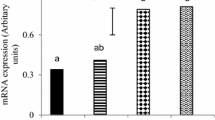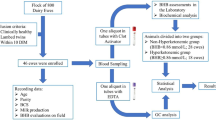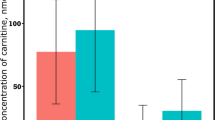Abstract
Based on current knowledge, C16 and C18 fatty acids (FA) are considered the most functional FA in hepatic metabolism. Although these FAs have been satisfyingly investigated in cattle, other species such as camel have been neglected. For this reason, the current study was designed to scrutinize changing patterns of C16 and C18 FAs in 10 dromedary camels from the last 2 months of gestation to the first months of lactation. Camels were grazed on natural pasture and supplemented with a balanced ration. Liver biopsies were obtained through blind biopsy technique at about 60, 45, 30, and 15-day antepartum (AP), and at 3, 15, 30, 45, and 60 post-partum (PP). Data were analyzed by the ANOVA procedure of SPSS with repeated measurements. From 15-day AP, saturated FA content of the liver declined (P < 0.01) and 15-day PP reached its peak (P = 0.02). At 30-day PP it went down (P < 0.01), and re-elevated at 45-day PP (P < 0.01) but remained at a steady state for the duration of the study. Mono-unsaturated and polyunsaturated FA content of hepatic tissue were constant throughout AP, albeit observed to peak at 15-day AP compared with 45 (P = 0.04) and 30-day AP (P < 0.01) for mono-unsaturated FAs, and with 60-, 45-, and 30-day AP (P ≤ 0.01) for polyunsaturated FAs. The palmitic acid content of the liver reached a nadir at 30-day AP (P < 0.01), increased sharply (P < 0.01) at the next sampling time-point, and had a trend to escalate until 3-day PP. Palmitoleic acid levels were unchanged from 60- to 30-day AP, decreased at 15 AP and 3-day PP, increased at 15-day PP, then remained constant until the end of the study period (P ≤ 0.04). Stearic acid content started to grow at 15-day AP and reached its peak at 15-day PP (P < 0.01). At 30-day PP, stearic level in liver dropped abruptly (P < 0.01), then intensified at 45-day PP and did not change after; hepatic content of stearic acid was lower during AP compared with PP time-points. Other C18 FAs changed significantly during the study period. These results suggest that parturition could have a profound effect on FA composition and other metabolites in camel liver. Further research is required to establish the metabolic mechanism behind these changes.



Similar content being viewed by others
References
Ahmadpour, A., Aliarabi, H., Khan, M.G., Patton, R.A. and Bruckmaier, R.M., 2017. Temporal changes in milk fatty acid distribution due to feeding different levels of rolled safflower seeds to lactating Holstein cows, Journal of Dairy Science, 100, 4484–4499
Akbar, H., Grala, T.M., Vailati Riboni, M., Cardoso, F.C., Verkerk, G., McGowan, J., Macdonald, K., Webster, J., Schutz, K., Meier, S., Matthews, L., Roche, J.R. and Loor, J.J., 2015. Body condition score at calving affects systemic and hepatic transcriptome indicators of inflammation and nutrient metabolism in grazing dairy cows, Journal of Dairy Science, 98, 1019–1032
Al-Sobayil, F.A., 2009. Locations and techniques for percutaneous renal biopsy in adult dromedary camels (Camelus dromedarius), Bulgarian Journal of Veterinary Medicine, 12, 298–302
Association of Official Analytical Chemists, 1990. Official methods of analysis of the Association of Official Analytical Chemists, AOAC, Arlington
Bionaz, M., Thering, B.J. and Loor, J.J., 2012. Fine metabolic regulation in ruminants via nutrient-gene interactions: saturated long-chain fatty acids increase expression of genes involved in lipid metabolism and immune response partly through PPAR-α activation, British Journal of Nutrition, 107, 179–191
Cebra, C.K., 2009. Disorders of carbohydrate or lipid metabolism in camelids Veterinary Clinics: Food Animal Practice, 25, 339–352
Chouinard, P.Y., Corneau, L., Barbano, D.M., Metzger, L.E. and Bauman, D.E., 1999. Conjugated linoleic acids alter milk fatty acid composition and inhibit milk fat secretion in dairy cows, The Journal of Nutrition, 129, 1579–1584
Contreras, G.A. and Sordillo, L.M., 2011. Lipid mobilization and inflammatory responses during the transition period of dairy cows, Comparative Immunology, Microbiology, and Infectious Diseases, 34, 281–289
Douglas, G.N., Rehage, J., Beaulieu, A.D., Bahaa, A.O. and Drackley, J.K., 2007. Prepartum nutrition alters fatty acid composition in plasma, adipose tissue, and liver lipids of periparturient dairy cows, Journal of Dairy Science, 90, 2941–2959
Emery, R.S., Liesman, J.S. and Herdt, T.H., 1992. Metabolism of long chain fatty acids by the ruminant liver, The Journal of Nutrition, 122, 832–837
Farid, M.F.A., 1995. Nutrient requirements of dromedary camels: protein and energy requirements for maintenance, Journal of Arid Environments, 30, 207–218
Faye, B., Bengoumi, M., Cleradin, A., Tabarani, A. and Chilliard, Y., 2001. Body condition score in dromedary camel: a tool for management of reproduction, Emirate Journal of Agricultural Science, 13, 1–6
Folch, J., Lees, M. and Sloane Stanley, G.H., 1957. A simple method for the isolation and purification of total lipids from animal tissues, The Journal of Biological Chemistry, 226, 497–509
Gross, J.J., Kessler, E.C., Albrecht, C. and Bruckmaier, R.M., 2015. The response of cholesterol metabolism to a negative energy balance in dairy cows depends on the lactational stage, Plos One, 10, 1–17
Hara, A. and Radin, N.S., 1978. Lipid extraction of tissues with a low-toxicity solvent, Analytical Biochemistry, 90, 420–426
Ingvartsen, K.L., and Moyes, K., 2013. Nutrition, immune function, and health of dairy cattle, Animal, 7, 112–122
Khadge, S., Thiele, G.M., Sharp, J.G., McGuire, T.R., Klassen, L.W., Black, P.N., DiRusso, C.C., Cook, L. and Talmadge, J.E., 2018. Long-chain omega-3 polyunsaturated fatty acids decrease mammary tumor growth, multiorgan metastasis and enhance survival, Clinical & Experimental Metastasis, 38, 797–818
Khan, R., Shahzad, M.I. and Iqbal, M.N., 2016. Role of a camel in the pastoral mode of life and future use of rCGH as a therapeutic agent in milk and meat production, PSM Veterinary Research, 1, 32–39
Litherland, N.B., Dann, H.M. and Drackley, J.K., 2011. Prepartum nutrient intake alters palmitate metabolism by liver slices from peripartal dairy cows1, Journal of Dairy Science, 94, 1928–1940
Liu, S., Hatano, B., Zhao, M., Yen, C.-C., Kang, K., Reilly, S.M., Gangl, M.R., Gorgun, C., Balschi, J.A., Ntambi, J.M. and Lee, C.-H., 2011. Role of peroxisome proliferator-activated receptor δ/β in hepatic metabolic regulation, Journal of Biological Chemistry, 286, 1237–1247
Loften, J.R., Linn, J.G., Drackley, J.K., Jenkins, T.C., Soderholm, C.G. and Kertz, A.F., 2014. Invited review: palmitic and stearic acid metabolism in lactating dairy cows, Journal of Dairy Science, 97, 4661–4674
Mashek, D.G. and Grummer, R.R., 2003. Effects of long chain fatty acids on lipid and glucose metabolism in monolayer cultures of bovine hepatocytes, Journal of Dairy Science, 86, 2390–2396
Mei, S., Ni, H.-M., Manley, S., Bockus, A., Kassel, K.M., Luyendyk, J.P., Copple, B.L. and Ding, W.-X., 2011. Differential roles of unsaturated and saturated fatty acids on autophagy and apoptosis in hepatocytes, Journal of Pharmacology and Experimental Therapeutics, 339, 487–498
Mirzaei-Alamouti, H., Mohammadi, Z., Shahir, M.H., Vazirigohar, M. and Mansouryar, M., 2018. Effects of short-term feeding of different sources of fatty acids in pre-mating diets on reproductive performance and blood metabolites of fat-tailed Iranian Afshari ewes, Theriogenology, 113, 85–91
Nakamura, M.T., Yudell, B.E. and Loor, J.J., 2014. Regulation of energy metabolism by long-chain fatty acids, Progress in Lipid Research, 53, 124–144
Nasser, B., Kebbaj, M.S.E., Moustaid, K., Bagri, A., Essamadi, A. and Latruffe, N., 2015. Lipid analysis of tissues from camel (Camelus dromedaries) reveals unique composition in fatty acids, International Journal of Scientific and Engineering Research, 6, 270–276
Rukkwamsuk, T., Geelen, M.J.H., Kruip, T.A.M., and Wensing, T., 2000. Interrelation of fatty acid composition in adipose tissue, serum, and liver of dairy cows during the development of fatty liver postpartum, Journal of Dairy Science, 83, 52–59
Rukkwamsuk, T., Kruip, T.A.M., Meijer, G.A.L., and Wensing, T., 1999. Hepatic fatty acid composition in Periparturient dairy cows with fatty liver induced by intake of a high energy diet in the dry period, Journal of Dairy Science, 82, 280–287
Sato, H. and Inoue, A., 2006. The decrease in stearic acid proportions in adipose tissues and liver lipids in the fatty liver of dairy cows, Animal Science Journal, 77, 347–351
Shibani, M., Ringseis, R., Alkazali, M., Kerfakh, O. and Eder, K., 2011. Concentrations of conjugated linoleic acids in milk and tissues from single-humped Arabian camel (Camelus dromedaries) kept under intensive standardized management, African Journal of Agricultural Research, 6, 3470–3474
Singh, R., Kaushik, S., Wang, Y., Xiang, Y., Novak, I., Komatsu, M., Tanaka, K., Cuervo, A.M. and Czaja, M.J., 2009. Autophagy regulates lipid metabolism, Nature, 458, 1131–1135
Smith, S.B., Hively, T.S., Cortese, G.M., Han, J.J., Chung, K.Y., Casteñada, P., Gilbert, C.D., Adams, V.L. and Mersmann, H.J., 2002. Conjugated linoleic acid depresses the δ9 desaturase index and stearoyl-coenzyme A desaturase enzyme activity in porcine subcutaneous adipose tissue, Journal of Animal Science, 80, 2110–2115
Smith, S.B., Lunt, D.K., Chung, K.Y., Choi, C.B., Tume, R.K. and Zembayashi, M., 2006. Adiposity, fatty acid composition, and delta-9 desaturase activity during growth in beef cattle, Animal Science Journal, 77, 478–486
Van Soest, P.J., Robertson, J.B. and Lewis, B.A., 1991. Methods for dietary fiber, neutral detergent fiber, and nonstarch polysaccharides in relation to animal nutrition, Journal of Dairy Science, 74, 3583–3597
Vargas-Bello-Pérez, E., Loor, J.J. and Garnsworthy, P.C., 2018. Effect of different exogenous fatty acids on the cytosolic triacylglycerol content in bovine mammary cells, Animal Nutrition, https://doi.org/10.1016/j.aninu.2018.09.002
Yonezawa, T., Yonekura, S., Kobayashi, Y., Hagino, A., Katoh, K. and Obara, Y., 2004. Effects of long-chain fatty acids on cytosolic triacylglycerol accumulation and lipid droplet formation in primary cultured bovine mammary epithelial cells, Journal of Dairy Science, 87, 2527–2534
Acknowledgments
The authors thank the expert technical assistance of SabzBavaran-e-NouAndish Co. for providing laboratory assistance and equipment. They also appreciate the clan of Jaàfârbiglou from Qashqaei Tribal Confederation for providing the animals and housing facilities.
Funding
This study was fully funded by the R&D grant from SabzBavaran-e-NouAndish Rural Co-op Company for research on physiological and nutritional improvement of the local dromedary camel herds (Shiraz, Fars, I.R. Iran; grant no. 229-707333-1/4).
Author information
Authors and Affiliations
Corresponding author
Ethics declarations
All procedures performed in the study involving camels were following the ethical standards of SabzBavaran-e-NouAndish Co. Policies on Experimental and Research Animal Rights (policy no. 73-336/1239-5).
Conflict of interest
The authors declare that they have no conflict of interest.
Additional information
Publisher’s note
Springer Nature remains neutral with regard to jurisdictional claims in published maps and institutional affiliations.
Electronic supplementary material
ESM 1
(DOCX 915 kb)
Rights and permissions
About this article
Cite this article
Ahmadpour, A., Christensen, R.G., Zarrin, M. et al. Reporting temporal fluctuations of hepatic C16 and C18 fatty acids during late gestation and early lactation in dromedary camel. Trop Anim Health Prod 51, 1651–1660 (2019). https://doi.org/10.1007/s11250-019-01860-y
Received:
Accepted:
Published:
Issue Date:
DOI: https://doi.org/10.1007/s11250-019-01860-y




